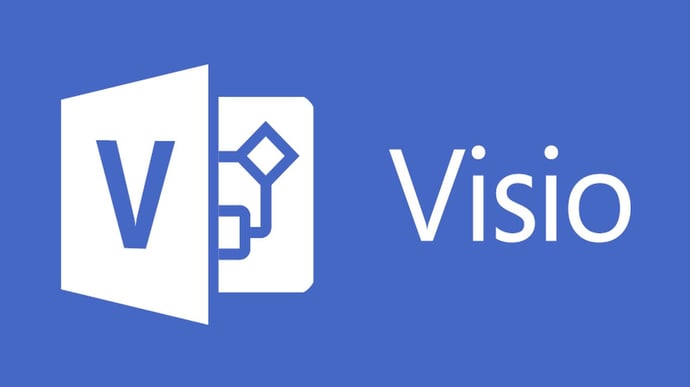If you’re thinking about process mapping and Business Process Management, you’ve probably compared IBM Blueworks vs Microsoft Visio software. But which one is best?
Well, ultimately this depends on what you want to achieve. Both tools have their pros and cons and we’ve weighed up the benefits and limitations of each to help you decide which system would be best suited to help you achieve your process improvement goals and objectives.
If you would like to do some more research, you can also take a look at any of our other comparison articles which will give you an excellent insight into the positives and negatives of potential BPM suppliers:
Appian vs Pega vs Bizagi: Which Is The Best BPM Software?
A review of Casewise vs Aris: Which is the best Business Process Management (BPM) software?
Now it's time to put these two to the test.
IBM Blueworks vs Microsoft Visio
IBM Blueworks

Blueworks Live is IBM’s flagship cloud-based Process Modeller and has been designed to be simple to use with no training required. This all singing, all dancing BPM platform allows you to build your business processes quickly and easily so that they can be shared across your organisation.
What are the benefits of IBM Blueworks?
The biggest benefit of Blueworks is that it is cloud-based. If you do not have the IT resource available to install and maintain an in-house server, then this would be a great option. IBM’s BPM system also comes with a whole host of functionality to help you ‘drive out inefficiencies and improve business operations.’
Other benefits include:
- Sophisticated process management platform
- Specific custom properties for documentation
- Analysis and comparison of process metrics
- Sharing processes in the cloud
- Automatically back up and save
What are the limitations of IBM Blueworks?
As Blueworks is one of the big boys in the BPM space, it is at the higher end of the price spectrum. If you are planning to use all of the functionality available for a process improvement project or implementation of a Lean framework for example; then it is probably quite good value for money. However if you are simply looking for a process mapping tool and aren’t interested in the bells and whistles, it might be worth looking for a different system. The main limitations are in the licensing of the product, but there are others:
- Process maps can only be created by someone with a user licence
- Process maps are invisible to end-users unless they have a viewer licence
- It is difficult to find or search for information in processes
- There are limitations in sharing and exporting to different applications
- Limited reporting capabilities
Microsoft Visio

Visio is Microsoft’s own flowchart and diagramming tool, which allows you to create simple process maps quickly and with minimal effort. As Visio is part of Microsoft’s Office offering it is easy to purchase and install and offers clear licencing options depending on the number of users you have. The software comes with a variety of pre-loaded shape templates that meet industry standards such as UML and BPMN.
What are the benefits of using Microsoft Visio for Process Mapping?
Microsoft Visio is incredibly easy to use, and is compatible not only with Microsoft’s own portfolio of applications but also with a variety of other software systems. If your primary business requirement is to identify and capture processes then Visio is an excellent choice. However, the real benefits of using Visio only come when it is used in conjunction with a BPM system, which allows process maps to be created and shared across the organisation, and opens up specific reporting capabilities as required for business analysis.
Key benefits include:
- Ability to create maps in a variety of different formats
- Easy to use drag and drop functionality
- Customisable shape templates
- Ability to link data to shapes using other applications such as Microsoft Excel
What are the limitations of Microsoft Visio?
When used in isolation, Microsoft Visio is very limited. If you want more than just a simple process mapping tool it might be worth looking into BPM platforms that harness the power of Visio and incorporate it into the software. Stand-alone Visio is also unregulated so it is very easy for process maps to be created in lots of different styles and formats, especially if there are several process authors. This is not ideal if you are looking for a more standardised approach to process mapping.
Some other limitations include:
- No central location to store process maps
- Difficult to share maps across the organisation without a dedicated BPM system
- Limited customisation and design options available
- Limited reporting capabilities
- Limited options to add data to shapes
If you're interested in diving deeper into the BPM pool, I suggest that you download our comprehensive process mapping guide below:
Related articles:
Best Business Process Management Software: A brief review
Microsoft Visio and SharePoint vs. a purpose-built Business Process Management System
Bizagi vs Auraportal: Which is the Best BPM Software?Written by Isobel Witts
Isobel joined Triaster in September 2014 as our Customer Success Administrator. After about a year in the role she decided marketing was where her main interest lay and she began working with Emma as a new Triaster website was developed and the Triaster blog was started. The move was very successful, resulting in her moving full time into a marketing role, firstly at Triaster and subsequently for a local marketing agency.

